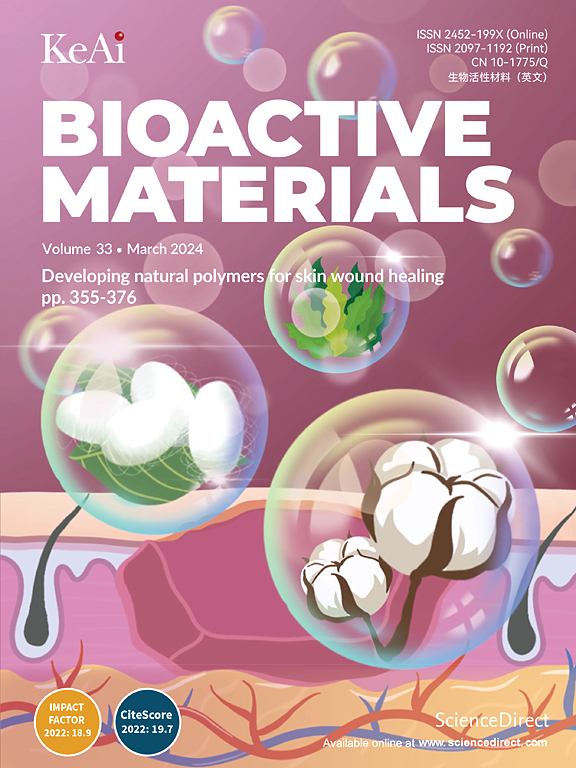Protein to biomaterials: Unraveling the antiviral and proangiogenic activities of Ac-Tβ1-17 peptide, a thymosin β4 metabolite, and its implications in peptide-scaffold preparation
IF 18
1区 医学
Q1 ENGINEERING, BIOMEDICAL
引用次数: 0
Abstract
Peptide metabolites are emerging biomolecules with numerous possibilities in biomaterial-based regenerative medicine due to their inherent bioactivities. These small, naturally occurring compounds are intermediates or byproducts of larger proteins and peptides, and they can have profound effects, such as antiviral therapeutics, proangiogenic agents, and regenerative medicinal applications. This study is among the first to focus on using thymosin β4 protein-derived metabolites to pioneer novel applications for peptide metabolites in biomaterials. This study found that the novel peptide metabolite acetyl-thymosin β4 (amino acid 1–17) (Ac-Tβ1-17) exhibited significant protease inhibition activity against SARS-CoV-2, surpassing its precursor protein. Additionally, Ac-Tβ1-17 demonstrated beneficial effects, such as cell proliferation, wound healing, and scavenging of reactive oxygen species (ROS) in human umbilical vein endothelial cells (HUVEC). Integrating Ac-Tβ1-17 into a peptide-based scaffold facilitated cell growth and angiogenesis inside the scaffold and through gradual release into the surrounding environment. The Ac-Tβ1-17 peptide treatment induced significant biochemical responses in HUVEC, increasing Akt, ERK, PI3K, MEK, and Bcl-2 gene expression and proangiogenic proteins. Ac-Tβ1-17 peptide treatment showed similar results in ex vivo by enhancing mouse fetal metatarsal growth and angiogenesis. These findings highlight the potential of natural protein metabolites to generate biologically active peptides, offering a novel strategy for enhancing biomaterial compatibility. This approach holds promise for developing therapeutic biomaterials using peptide metabolites, presenting exciting prospects for future research and applications.

蛋白到生物材料:揭示胸腺素β4代谢物ac - t - β1-17肽的抗病毒和促血管生成活性,及其在肽支架制备中的意义
肽代谢物由于其固有的生物活性,在基于生物材料的再生医学中具有广阔的应用前景。这些天然存在的小化合物是较大的蛋白质和肽的中间体或副产物,它们可以具有深远的作用,例如抗病毒治疗,促血管生成剂和再生医学应用。这项研究是第一个利用胸腺蛋白酶β4蛋白衍生代谢物来开拓肽代谢物在生物材料中的新应用的研究之一。本研究发现,新型肽代谢物乙酰胸腺素β4(氨基酸1-17)(Ac-Tβ1-17)对SARS-CoV-2表现出显著的蛋白酶抑制活性,超过其前体蛋白。此外,Ac-Tβ1-17在人脐静脉内皮细胞(HUVEC)中显示出有益的作用,如细胞增殖、伤口愈合和清除活性氧(ROS)。将Ac-Tβ1-17整合到肽基支架中,促进支架内细胞生长和血管生成,并逐渐释放到周围环境中。Ac-Tβ1-17肽处理在HUVEC中诱导了显著的生化反应,增加了Akt、ERK、PI3K、MEK和Bcl-2基因表达和促血管生成蛋白。ac - t - β1-17肽处理可促进小鼠胎儿跖骨生长和血管生成。这些发现强调了天然蛋白质代谢物产生生物活性肽的潜力,为增强生物材料相容性提供了一种新的策略。这种方法有望利用肽代谢物开发治疗性生物材料,为未来的研究和应用提供令人兴奋的前景。
本文章由计算机程序翻译,如有差异,请以英文原文为准。
求助全文
约1分钟内获得全文
求助全文
来源期刊

Bioactive Materials
Biochemistry, Genetics and Molecular Biology-Biotechnology
CiteScore
28.00
自引率
6.30%
发文量
436
审稿时长
20 days
期刊介绍:
Bioactive Materials is a peer-reviewed research publication that focuses on advancements in bioactive materials. The journal accepts research papers, reviews, and rapid communications in the field of next-generation biomaterials that interact with cells, tissues, and organs in various living organisms.
The primary goal of Bioactive Materials is to promote the science and engineering of biomaterials that exhibit adaptiveness to the biological environment. These materials are specifically designed to stimulate or direct appropriate cell and tissue responses or regulate interactions with microorganisms.
The journal covers a wide range of bioactive materials, including those that are engineered or designed in terms of their physical form (e.g. particulate, fiber), topology (e.g. porosity, surface roughness), or dimensions (ranging from macro to nano-scales). Contributions are sought from the following categories of bioactive materials:
Bioactive metals and alloys
Bioactive inorganics: ceramics, glasses, and carbon-based materials
Bioactive polymers and gels
Bioactive materials derived from natural sources
Bioactive composites
These materials find applications in human and veterinary medicine, such as implants, tissue engineering scaffolds, cell/drug/gene carriers, as well as imaging and sensing devices.
 求助内容:
求助内容: 应助结果提醒方式:
应助结果提醒方式:


